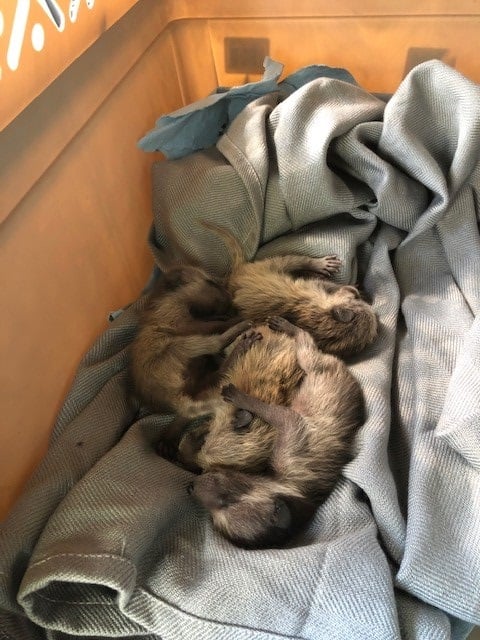Raccoons are ever recognizable with their black-masked face and nocturnal habits. The natural habitat for raccoons is wooded areas close to water. Hollow trees are the natural den sites for raccoons. But they have adapted to the urban and suburban habitats in Dallas.
Signs You Have a Raccoon Problem
Raccoons are nocturnal and leave clear signs of their presence:
- Raccoon Sounds in Attic or Walls: Scratching, heavy thumping, chirping, or growling.
- Distinct Tracks and Droppings: Hand-shaped footprints near walls, attics, and vents; dark tube-like droppings clustered near nesting sites.
- Trash and Property Disturbances: Raccoons are notorious for rummaging through trash.
Why Are Raccoons in the House?
Raccoons are on your property (either in your yard or your house) in search of food and shelter.
Raccoons will den in the space under a porch or deck, inside sheds, climb into chimneys, or in your attic.
Female raccoons may destroy and enter parts of your home, especially your attic, to create a suitable place to raise their young. Raccoons usually mate between late January and mid-March. Dallas homeowners start to notice a raccoon litter in April or May.
Common reasons they invade properties include:
Unsecured trash & pet food
Easy food sources attract raccoons.
Attic & chimney shelter
Raccoons prefer warm, safe nesting sites, especially in winter.
Gaps & weak entry points
Raccoons squeeze through vents, crawl spaces, softs, and roofing gaps.
Nearby water sources
Birdbaths, pet bowls, and leaky pipes invite raccoons.
Most people know raccoons are carriers of rabies, which can be deadly to people and pets. Raccoons are dangerous because they can spread other diseases, destroy your home, and potentially attack. Do not approach a raccoon inside your attic!
How Critter Control Gets Rid of Raccoons in Dallas
Critter Control has been providing raccoon removal in DFW for decades. Our experts have the experience and training to recognize all potential raccoon entry points and damage caused by a raccoon. Based on the comprehensive inspection, our raccoon removal process safely traps and removes the animal and repairs all damage.
Raccoon Trapping Near You

A cage trap is the most effective and humane raccoon trap. Keep 12 inches around the trap clear. Raccoons have extremely dexterous front paws with five long, tapered fingers and long nails. Raccoons destroy everything they can get their hands on when trapped.
Place your live trap in areas where you see signs of raccoon activity. Inside your home look for signs of tracks or paw prints and raccoon droppings. Outside of your home, look for raccoon droppings, dens, or animal runways. Setting multiple traps in different locations along their pathways can yield better results.
Secure the trap and protect the animal. If you set a trap on the roof, make sure it is secure! Unless the trap can be stabilized, it is not safe for a raccoon to be in a trap on a pitched roof. You should use a trap that has some covering to protect the animal from the elements.
Bait the trap with sweet items to reduce non-target captures. You can purchase sweet pasts. Fruits like cherries or grapes, marshmallows or jelly work effectively as raccoon bait.
Direct capture is not commonly used because raccoons are a rabies vector species. If legal, a healthy trapped raccoon will be relocated with written permission. When babies are removed from an attic, our wildlife specialists seek help from a local wildlife rehabilitation center.
Raccoon Control Near You & Exclusion
Preventative exclusion services are the most effective raccoon control in Philly. After raccoon removal, it is imperative to seal all entry points to prevent future entry. Ensuring you don’t create a home for raccoons outside your property will also help prevent attracting raccoons. However, habitat modification will become very important for prevention after dealing with a raccoon invasion. Repellents offer temporary solutions. Raccoons grow accustomed to frightening devices, and there are no toxicants regulated for raccoons.

Why Choose Critter Control?
40+ Years of Raccoon Control Expertise
☑Licenses & Insured Wildlife Removal Professionals
☑Safe, Humane, & Environmentally Responsible Methods
☑100% Customer Satisfaction Guarantee
The Critter Control Difference
Wildlife Removal in Dallas
Signs of raccoons include loud noises in the attic or walls, overturned trash cans, scattered debris, claw marks, raccoon droppings, or noticeable damage to roofing, siding, or vents.
Yes, raccoons can be dangerous as they may carry diseases like rabies, leptospirosis, or raccoon roundworm. They can also be aggressive if cornered or threatened.
While DIY removal might seem appealing, it’s safer and more effective to hire professionals. They have the knowledge, tools, and permits required to handle raccoons humanely and in compliance with local laws.
Call Critter Control in Dallas-Fort Worth! If you’re dealing with a raccoon infestation, you should call a professional wildlife control operator and not a pest control company or exterminator. You can reach Critter Control at 214-571-4539.
Prevention steps include securing trash cans, sealing entry points to attics or crawlspaces, trimming tree branches near the roof, and removing food sources like pet food or birdseed from outdoor areas.